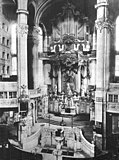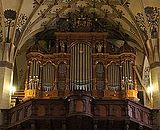Julius Jahn & Son
Julius Jahn & Sohn was an organ building company in Dresden ( Saxony ). The family business existed from around 1907 to 1933 and was one of the leading Saxon organ building companies of its time. It was run in the third generation by Johannes Jahn until his death and was located at Josephinenstraße 18. Of the more than 40 new organs , except for the organ in the Johannisfriedhof in Dresden, none of the instruments have survived today. The Jahn organ of the Dresden Reconciliation Church was brought closer to its original state during a restoration between 2008 and 2011.
history
The family business was founded by Johann Friedrich Nikolaus Jahn (born August 19, 1798; † 1875) from Thuringia . He married the widow of Carl August Kayser and continued his workshop, which had been founded by Johann Christian Kayser . The son Julius Ferdinand E. Jahn (born May 31, 1829 in Dresden, † October 14, 1910 in Dresden) is proven to be Emil Wiegand's journeyman around 1861. His son Johannes Jahn (born January 24, 1868 - February 21, 1933) was probably influential in the company even before his father's death. Around 1900 the company manufactured pneumatic cone chests , from 1909 also electric action mechanisms . In 1904 Johannes was appointed "Royal Saxon Court Organ Builder". In the same year he became a partner, from 1910 owner of the family company that operated under the name "Julius Jahn & Sohn" from around 1907. With the death of Johannes Jahn, the company went out in 1933.
plant
Some innovative technical innovations were introduced into organ building under Johann Jahn. Instead of the Bark lever, he used a pneumatic working bellows and in 1911/1912 he invented a 20-fold setting system based on a punched card system . From 1899 he made pipes out of porcelain and created the first organ with porcelain pipes . In addition to over 40 new organs, as many existing organs were rebuilt and arrangements changed, including some organs by Gottfried Silbermann . In terms of style, the works of the third generation are influenced by the late Romantic period. The fact that not many works have survived is due to the changing taste from 1925 onwards in the course of the organ movement , as a result of which Jahn organs were replaced or profoundly rebuilt. Other instruments did not have a long service life because they used inferior material. Still other instruments were destroyed in World War II.
List of works (selection)
The size of the instruments is indicated by the number of manuals (Roman numerals) and the number of sounding registers (Arabic numerals). A separate pedal is indicated by a capital "P". Italics indicate that the organ in question is no longer or only the prospectus has been preserved.
| year | place | church | image | Manuals | register | info |
|---|---|---|---|---|---|---|
| 1907 | Gröba near Riesa | Ev.-luth. church | II / P | 25th | Behind the prospectus by Johann Georg Friedlieb Zöllner (1795), 1978 restoration and change of disposition by Johannes Schubert | |
| 1908 | Bernsbach | Parish church for the glory of God | II / P | 29 | behind the prospectus of the Trampeli organ ; Replaced in 1999 by a new building by Georg Wünning | |
| 1908 | Netzschkau | Evangelical castle church | II / P | 29 | Dilapidated in the 1950s, partially repaired in 1956, demolished in 1980, replaced in 1981 by relocating an organ originally from Schmidt & Berger | |
| 1909 | Wildbach near Bad Schlema | Wildbach village church | II / P | Extension of the organ by Johann Andreas Hesse (1814) | ||
| 1909 | Dresden | Anne's Church | III / P | 50 | changed after the Second World War | |
| 1909 | Dresden- Striesen | Church of Reconciliation | III / P | 49 | After reconstruction in 1939, the organ was partially brought closer to its original state in several construction phases in 2008–2011. However, the double function of the remote control (church / parish hall) was not restored, the remote control received a pneumatic instead of electro-pneumatic action and the organ a new console based on the Wilhelm Sauer design . | |
| 1910 | Rittmitz near Ostrau | Rittmitz Church | 12 | |||
| 1910 | Obergruna | Obergruna Church | II / P | 12 | ||
| around 1910 | Schmiedeberg | To the Holy Trinity | ||||
| 1911 | Dresden- Tolkewitz | Tolkewitz urn grove , old crematorium | II / P | 16 | 1947 expanded by Jehmlich; Conversion to electropneumatic action; 2014/2015 restoration by Ekkehart Groß | |
| 1912 | Pulsnitz | St. Nicolai | III / P | 35 | ||
| 1912 | Rabenau | St. Egidien | II / P | 20th | ||
| 1912 | Crandorf | Crandorf Church | II / P | 23 | ||
| 1913 | Ruppertsgrün | St. Anne | ||||
| 1904 and 1915 | Leipzig | Pauline Church | III / P | 92 | Extension of the organ by Johann Gottlob Mende (1843) and Friedrich Ladegast (1874, III / P / 66); Destroyed in 1968 when the church was blown up | |
| 1915-1916 | Oberbobritzsch | St. Nikolai | I / P | 13 | Major reconstruction of the organ by Gottfried Silbermann (1714–1716) | |
| 1915-1916 | Dresden | woman Church | III / P | 43 | Extension of the organ by Gottfried Silbermann (1732–1736) to IV / P / 65 and reconstruction, destruction 1945 → organ | |
| 1917-1919 | Schellerhau | Schellerhau village church | not received | |||
| 1927 | Pirna | Marienkirche | III / P | 56 | Expansion of the organ by Friedrich Nikolaus Jahn (1842, II / P / 44) behind the Jahn case from 1890; Rebuilt by Eule in 1950 and 1979, restored in 2005; received changed | |
| 1928 | Dresden- Tolkewitz | Johannisfriedhof | II / P | 15th | only originally preserved Jahn organ | |
| 1929 | Dresden- Trachau | Apostle Church | Replaced in 1958 by a new building by Alexander Schuke | |||
| 1929-1930 | Eckartsberga | City Church | II / P | 20th |
literature
- Hermann Fischer : 100 years of the Association of German Organ Builders . Orgelbau-Fachverlag, Lauffen 1991, ISBN 3-921848-18-0 , p. 215 .
- Frank-Harald Greß , Michael Lange: The organs of Gottfried Silbermann (= publications of the Society of Organ Friends, 177 ). 3. Edition. Sandstein, Dresden 2007, ISBN 978-3-930382-50-7 .
- Uwe Pape (Ed.): Lexicon of North German Organ Builders. Vol. 1: Thuringia and the surrounding area . Pape, Berlin 2009, ISBN 978-3-921140-86-4 , pp. 139-140 .
- Uwe Pape, Wolfram Hackel (Ed.): Lexicon of North German Organ Builders. Vol. 2: Saxony and the surrounding area . Pape, Berlin 2012, ISBN 978-3-921140-92-5 , pp. 163-164 .
Web links
- Julius Jahn in the Dresden Lexicon
- Jiri Kocourek: The organ builder Johannes Jahn and his work
Individual evidence
- ↑ a b Julius Jahn in the Dresden Lexikon , accessed on September 14, 2019.
- ^ Pape (Ed.): Lexicon of North German Organ Builders. Vol. 1: Thuringia and the surrounding area. 2009, p. 139.
- ^ Fischer: 100 years of the Association of German Master Organ Builders. 1991, p. 215.
- ^ Pape, Hackel (Ed.): Lexicon of North German Organ Builders. Vol. 2: Saxony and the surrounding area. 2012, p. 164.
- ^ History of the organ in Brockwitz , accessed on September 14, 2019.
- ^ Jahn organ of the Church of Reconciliation in Dresden-Striesen , accessed on September 14, 2019.
- ↑ Urnenhain Dresden: Orgelromantik ( Memento from April 2, 2015 in the Internet Archive ) (PDF file; 1.57 MB), accessed on September 14, 2019.
- ↑ Greß: Gottfried Silbermann's organs. 2007, p. 137 f.
Coordinates: 51 ° 2 ′ 38 " N , 13 ° 43 ′ 53.4" E



